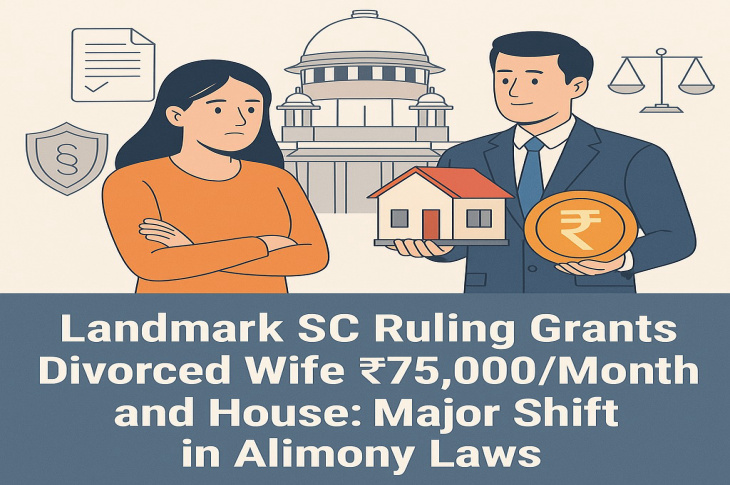Landmark SC Ruling Grants Divorced Wife ₹75,000/Month and House: Major Shift in Alimony Laws
In a major judgment that will impact divorce laws across India, the Supreme Court has significantly increased the monthly alimony for a divorced but unmarried woman from ₹20,000 to ₹50,000. The Court also ruled that the woman will receive a 5% increase in this amount every two years to adjust for inflation. In addition, the woman will get full ownership of the house she shared with her ex-husband.
This decision was given in the case of Rakhi Sadhukhan vs. Raja Sadhukhan and is now seen as a turning point in how courts decide alimony and maintenance matters in India.
People Also Read: New Rules For Divorce In India 2024: A Comprehensive Guide
Why This Judgment Matters
Before this ruling, many alimony payments did not keep up with rising living costs. Women who were financially dependent on their husbands often received low maintenance amounts that were not enough to support the lifestyle they had during marriage. This judgment changes that by:
-
Increasing the monthly alimony to a more reasonable figure
-
Including automatic increases every two years
-
Giving long-term residential security through property transfer
It sends a strong message that divorced spouses, especially women who stay unmarried, deserve financial stability and dignity after separation.
People Also Read: How To Apply For Divorce
The Story Behind the Case
Timeline:
-
Married in: 1997
-
Separated in: 2007
-
Divorce finalized in: 2019
Rakhi Sadhukhan had been fighting a legal battle for over 17 years. Initially, she was awarded ₹8,000/month as interim maintenance in 2010. This was increased to ₹20,000/month by the Calcutta High Court in 2016. But Rakhi argued that this amount was still too low, especially considering inflation and her standard of living during the marriage.
Her ex-husband, Raja Sadhukhan, claimed that he had limited income, responsibilities from a second marriage, and elderly parents to support. He also argued that their son, now an adult, was no longer dependent.
People Also Read: Comprehensive Guide to Divorce Documents in India: A Step-by-Step Approach
What the Supreme Court Decided
The Supreme Court reviewed all the facts and gave a clear, strong judgment:
-
Monthly Alimony Raised to ₹50,000: This is more than double the previous amount.
-
5% Increase Every 2 Years: To adjust for inflation and rising costs of living.
-
Home Ownership Given to Wife: The court ordered that the shared flat must be transferred to Rakhi’s name. The husband must also clear any outstanding home loan.
This combination of regular payments and property ownership ensures that Rakhi will have both income and a place to live, offering her long-term security.
People Also Read: Fastest Divorce Process : How To Get A Quick Divorce
Court’s Stand on Standard of Living
The court said that alimony is not just about survival. It should reflect the lifestyle the wife had during the marriage. This means courts must consider:
-
Quality of home
-
Healthcare access
-
Social and travel habits
-
Educational and personal development opportunities
This marks a shift in mindset: from viewing alimony as a handout to treating it as a way to maintain continuity in lifestyle.
People Also Read: Grounds of Divorce for Husband in India
Income Will Be Examined Closely
The court also made it clear that the paying spouse’s entire financial history will now matter. This includes:
-
Current salary
-
Past earnings
-
Undeclared income
-
Investments and assets
The husband’s excuse of a second marriage and aged parents was rejected. The court said that remarriage cannot be used to reduce support to the first wife.
This ensures fairness and stops people from hiding income to avoid paying fair alimony.
Inflation-Linked Alimony: Why It Matters
A major highlight of the judgment is the 5% hike in maintenance every two years. This is important because:
-
Traditional alimony amounts remained fixed
-
Cost of living keeps rising
-
Going back to court for revisions is time-consuming
Now, the increase is automatic. This provides security and avoids future legal battles.
People Also Read: Alimony Explained How To Calculate Alimony Maintenance In India
Property Instead of Monthly Payments
Another big takeaway is that the court allowed property to be used as part of the alimony. The marital home will now belong to the wife. This helps:
-
Avoid monthly payment issues
-
Ensure long-term shelter
-
Reduce stress and court follow-ups
This idea could become more common in future divorce settlements, especially in big cities where rents are high.
People Also Read: In a historic judgement, Supreme Court provides guidelines for deciding compensation and maintenance in matrimonial cases
Encouraging Quick Settlements
This case shows that long court battles can backfire. Initially, Rakhi got ₹8,000/month. Over the years, this was increased to ₹75,000/month when the husband failed to appear in court in 2023.
This shows that delays can lead to higher financial burdens. It also encourages both parties to settle early and fairly.
Maintenance vs. Inheritance
The court also made an important point: maintenance and inheritance are not the same. Divorce does not affect a child’s right to ancestral property.
This clarity helps avoid confusion and protects children’s future rights.
People Also Read: Understanding the Legal Rights of Women in Divorce Cases in India
Impact on Future Divorce Cases
This ruling will change how alimony is awarded in India:
-
Standard of living will be the key factor
-
Past and present income will be examined in detail
-
Inflation-linked increases may become standard
-
Property can be awarded instead of or in addition to monthly cash
Women who were underpaid in previous cases may now have a stronger case to request fairer terms.
People Also Read: Permanent and Interim Maintenance in Void Marriages: Legal Rights & Provisions
Final Thoughts
The Supreme Court’s decision in this case is a big step toward fairness in divorce settlements. It recognizes the years that many women dedicate to their families without earning income, and ensures that they are not left without support after a marriage ends.
This case is not just about one woman. It’s about setting a new standard—one where financial dignity after divorce is not optional, but necessary.
Download the Judgment Here:
Supreme Court JudgmentFrequently asked questions
Can the court give a house instead of monthly alimony?
Can the court give a house instead of monthly alimony?
Yes. In this case, the court ordered the husband to transfer the marital home to the wife.
What is inflation-linked alimony?
What is inflation-linked alimony?
It meansmaintenance amount will increase automatically—in this case, 5% every two years.
Will this judgment affect future cases?
Will this judgment affect future cases?
Yes. It sets a precedent and is likely to influence how other courts decide alimony matters.
Does remarriage affect alimony payments?
Does remarriage affect alimony payments?
No. The Supreme Court said remarriage or financial obligations to a new family do not reduce responsibility toward the first wife.
Can a divorced woman who never remarried get alimony?
Can a divorced woman who never remarried get alimony?
Yes. If she is not financially independent, she can claim alimony.
Trending
Frequently asked questions
Can the court give a house instead of monthly alimony?
Can the court give a house instead of monthly alimony?
Yes. In this case, the court ordered the husband to transfer the marital home to the wife.
What is inflation-linked alimony?
What is inflation-linked alimony?
It meansmaintenance amount will increase automatically—in this case, 5% every two years.
Will this judgment affect future cases?
Will this judgment affect future cases?
Yes. It sets a precedent and is likely to influence how other courts decide alimony matters.
Does remarriage affect alimony payments?
Does remarriage affect alimony payments?
No. The Supreme Court said remarriage or financial obligations to a new family do not reduce responsibility toward the first wife.
Can a divorced woman who never remarried get alimony?
Can a divorced woman who never remarried get alimony?
Yes. If she is not financially independent, she can claim alimony.



Ask a Lawyer